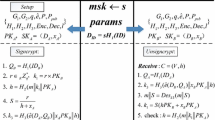Abstract
Signcryption ensures encryption and signature with minimum computational costs and overheads than compared to that of traditional signature model. Besides, Certificateless Signcryption resolves issues related to key escrow and reduces public key management for Wireless Sensor Network (WSN) setting. There has been some Certificateless Signcryption mechanisms proposed, most of which are proved secured using bilinear pairing operations. However, with pairing being computationally hard to understand and with involvement of heavy group operation minimizes the advantages gained from smaller key size. To address this issue, a scheme called, Quadratic Poly Certificateless Inductive Signcryption (QPCIS) for network security in WSN is presented without using bilinear pairing. The QPCIS scheme inherits the security of quadratic polynomial that possesses lower computation complexity than bilinear pairing. In QPCIS scheme, only designated receiver node recovers the data packet via base station by verifying validity of signcrypted data packet using Inductive Probability theorem. Experimental works are conducted on parameters like computational time, computational overhead, data security and data integrity rate. By evaluating the performance with related schemes, results show that the proposed QPCIS scheme is secure and computationally efficient.






Similar content being viewed by others
References
Yin A, Liang H (2014) Certificateless hybrid signcryption scheme for secure communication of wireless sensor networks. Wirel Pers Commun, Springer. https://doi.org/10.1007/s11277-014-2070-y
Li F, Han Y, Jin C (2016) Practical signcryption for secure communication of wireless sensor networks. Wirel Pers Commun 89(4):1391–1412
Jin C, Chen G, Yu C, Shan J, Zhao J, Jin Y (2018) An efficient heterogeneous signcryption for smart grid. PLoS One. https://doi.org/10.1371/journal.pone.0208311
Li F, Han Y, Jin C (2018) Cost-Effective and Anonymous Access Control for Wireless Body Area Networks. IEEE Syst J 12(1)747–758
Li F, Shirase M, Takagi T (2013) Certificateless hybrid signcryption. Math Comput Model 57(3-4):324–343
Zhou C, Gao G, Cui Z (2017) Certificateless signcryption in the standard model. Wirel Pers Commun 92(2):495–513
Luo M, Wan Y (2018) An enhanced certificateless signcryption in the standard model. Wirel Pers Commun 98:2693–2709.
Li L, Zhou S, Choo K-KR, Li X, He D (2018) An efficient and provably-secure certificateless proxy-signcryption scheme for electronic prescription system. Secur Commun Netw. https://doi.org/10.1155/2018/7524102
Eslami Z, Pakniat N (2014) Certificateless aggregate signcryption: security model and a concrete construction secure in the random oracle model. Journal of King Saud University – Computer and Information Sciences 26(3). https://doi.org/10.1016/j.jksuci.2014.03.006
Sharma G, Bala S, Verma AK (2015) Pairing-Free Certificateless Ring Signcryption (PF-CLRSC) scheme for wireless sensor networks. Wirel Pers Commun. https://doi.org/10.1007/s11277-015-2698-2
Yu H, Yang B (2017) Pairing-free and secure Certificateless Signcryption scheme. The Computer Journal 60(8): 1187–1196
Zia M, Ali R (2018) Cryptanalysis and improvement of an elliptic curve based signcryption scheme for firewalls. PLoS One. https://doi.org/10.1371/journal.pone.0208857
Gao Y, Dong X, Tian Y (2015) A new Signcryption scheme without certificate and linear pairing. Association for Computing Machinery ACM. https://doi.org/10.1145/3207677.3277995
Zhang B, Jia Z, Zhao C (2018) An efficient Certificateless generalized Signcryption scheme. Security and Communication Networks. https://doi.org/10.1155/2018/3578942
Li J, Zhao J, Zhang Y (2014) Certificateless online/offline signcryption scheme. Secur Commun Netw. https://doi.org/10.1002/sec.1146
Kamil IA, Ogundoyin SO (2018) An improved certificateless aggregate signature scheme without bilinear pairings for vehicular ad hoc networks. Journal of Information Security and Applications 44:184–200. https://doi.org/10.1016/j.jisa.2018.12.004
Yu H-f, Yang B (2017) Low-computation certificateless hybrid signcryption scheme. Front Inform Technol Electron Eng 18(7):928–940
Omala AA, Ali I, Li F (2018) Heterogeneous signcryption with keyword search for wireless body area network. https://doi.org/10.1002/spy2.25
Niu S, Niu L, Yang X, Wang C, Jia X (2017) Heterogeneous hybrid signcryption for multi message and multi receiver. PLoS One. https://doi.org/10.1371/journal.pone.0184407
Masmoudi R, Djebbar AB, Dayoub I (2017) Low complexity joint blind equalization and CFO estimation for MC-CDMA system. Wirel Pers Commun 92(2):315–331
Author information
Authors and Affiliations
Corresponding author
Additional information
Publisher’s note
Springer Nature remains neutral with regard to jurisdictional claims in published maps and institutional affiliations.
Rights and permissions
About this article
Cite this article
Sumithra, A. Quadratic Poly Certificateless Inductive Signcryption for Network Security. Mobile Netw Appl 26, 1586–1596 (2021). https://doi.org/10.1007/s11036-019-01496-0
Published:
Issue Date:
DOI: https://doi.org/10.1007/s11036-019-01496-0




